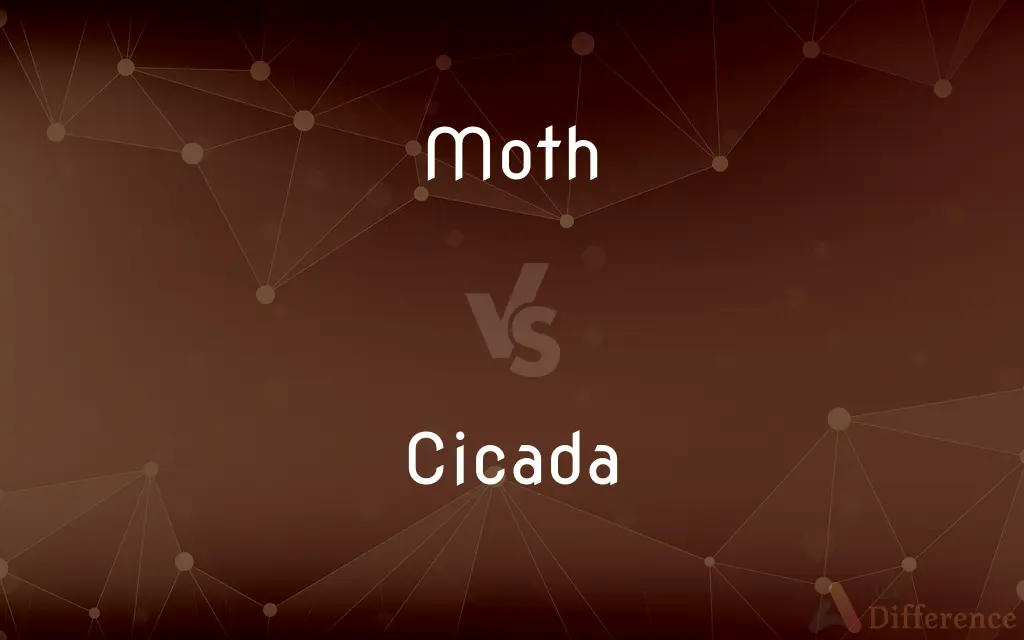Moth vs. Cicada — What's the Difference?
By Tayyaba Rehman & Fiza Rafique — Updated on March 18, 2024
Moths are nocturnal winged insects known for their attraction to light, with powdery wings, whereas cicadas are known for their daytime activity and loud mating calls, with clear, membranous wings.

Difference Between Moth and Cicada
Table of Contents
ADVERTISEMENT
Key Differences
Moths belong to the order Lepidoptera, closely related to butterflies, and are primarily active at night, drawn to lights and known for their silent flight. Cicadas, on the other hand, are part of the order Hemiptera and are famous for their daytime activity, particularly the males' distinctive and loud mating calls that can be heard in warm months.
While moths have a wide variety of wing patterns, often muted to camouflage against predators, cicadas typically have less variable appearance, with clear, membranous wings and a stout body, making them less diverse in coloration but distinctive in shape.
Moths undergo a complete metamorphosis, starting from egg to larva (caterpillar), then pupa, and finally, the young stage. Cicadas also experience a form of metamorphosis but are known for their unique life cycles, especially the periodical cicadas, which spend most of their lives underground as nymphs for 13 or 17 years before emerging to molt, mate, and die within a few weeks.
Moths are found worldwide, with a huge diversity of species ranging from benign to pests that can damage crops and textiles. Cicadas are also widespread but are most commonly found in warmer climates, with their presence often indicating healthy tree populations due to their sap-feeding nature.
Comparison Chart
Activity Time
Nocturnal
Diurnal (daytime)
ADVERTISEMENT
Wing Type
Powdery
Clear, membranous
Sound
Silent flight
Loud mating calls
Life Cycle
Complete metamorphosis
Unique cycles (e.g., 13 or 17 years underground)
Compare with Definitions
Moth
A nocturnal insect with powdery wings.
The moth fluttered towards the porch light.
Cicada
Spends years underground as nymphs.
After 17 years, the cicadas emerged en masse.
Moth
Wide variety of species.
The Atlas moth is one of the largest moths in the world.
Cicada
Known for their loud mating calls.
The summer air was filled with the sound of cicadas.
Moth
Some species are known pests.
The pantry moth has infested the flour and grains.
Cicada
Feeds on plant sap.
Cicadas use their mouthparts to draw sap from tree roots.
Moth
Attracted to light.
Moths gathered around the lamp in the dark garden.
Cicada
Membranous wings.
The cicada's clear wings caught the sunlight as it flew.
Moth
Undergoes a complete metamorphosis.
The caterpillar will soon cocoon itself and emerge as a moth.
Cicada
Indicator of healthy tree populations.
The abundance of cicadas suggests a healthy, mature forest.
Moth
Moths are a paraphyletic group of insects that includes all members of the order Lepidoptera that are not butterflies, with moths making up the vast majority of the order. There are thought to be approximately 160,000 species of moth, many of which have yet to be described.
Cicada
The cicadas ( or ) are a superfamily, the Cicadoidea, of insects in the order Hemiptera (true bugs). They are in the suborder Auchenorrhyncha, along with smaller jumping bugs such as leafhoppers and froghoppers.
Moth
Any of numerous insects of the order Lepidoptera, generally distinguished from butterflies by their nocturnal activity, hairlike or feathery antennae, stout bodies, and the frenulum that holds the front and back wings together.
Cicada
Any of various insects chiefly of the family Cicadidae, having a broad head, membranous wings, and in the male a pair of resonating organs that produce a characteristic high-pitched, droning sound.
Moth
A clothes moth.
Cicada
Any of several insects in the superfamily Cicadoidea, with small eyes wide apart on the head and transparent well-veined wings.
Moth
A usually nocturnal insect of the order Lepidoptera, distinguished from butterflies by feather-like antennae.
Cicada
The periodical cicada.
Moth
(figurative) Anything that gradually and silently eats, consumes, or wastes any other thing.
Cicada
Any species of the genus Cicada or of the family Cicadidae. They are large hemipterous insects, with nearly transparent wings. The male makes a shrill sound by peculiar organs in the under side of the abdomen, consisting of a pair of stretched membranes, acted upon by powerful muscles. A noted American species (Cicada septendecim) is called the seventeen year locust. Another common species is the dogday cicada.
Moth
The plant Vigna aconitifolia, moth bean.
Cicada
Stout-bodied insect with large membranous wings; male has drum-like organs for producing a high-pitched drone
Moth
(intransitive) To hunt for moths.
Moth
A mote.
Moth
Any nocturnal lepidopterous insect, or any not included among the butterflies; as, the luna moth; Io moth; hawk moth.
Moth
Any lepidopterous insect that feeds upon garments, grain, etc.; as, the clothes moth; grain moth; bee moth. See these terms under Clothes, Grain, etc.
Moth
Any one of various other insects that destroy woolen and fur goods, etc., esp. the larvæ of several species of beetles of the genera Dermestes and Anthrenus. Carpet moths are often the larvæ of Anthrenus. See Carpet beetle, under Carpet, Dermestes, Anthrenus.
Moth
Anything which gradually and silently eats, consumes, or wastes any other thing.
Moth
Typically crepuscular or nocturnal insect having a stout body and feathery or hairlike antennae
Common Curiosities
Why are moths attracted to light?
Moths are thought to navigate by natural light sources, and artificial lights can confuse their navigation systems.
Why are cicadas so loud?
Male cicadas produce loud calls to attract females for mating, with some species being among the loudest insects.
What is the purpose of a moth's powdery wings?
The powder on moth wings is made of tiny scales that can help them escape from predators' grasp.
How do moths communicate?
Moths primarily communicate through pheromones rather than sounds, especially for mating purposes.
Are cicadas considered pests?
While cicadas can damage young trees when laying eggs, they are generally not considered harmful pests.
What's the difference between a moth and a butterfly?
Moths typically have feathery or comb-like antennae and are nocturnal, while butterflies have slender antennae with club-shaped tips and are diurnal.
How do cicadas survive underground?
Cicada nymphs survive by feeding on the sap from tree roots, growing slowly until they are ready to emerge.
Can cicadas harm humans?
Cicadas are harmless to humans; they do not sting or bite and are primarily focused on mating and laying eggs.
Do cicadas sing at night?
Most cicada species are active and sing during the day, but there are a few species that are active at dusk or at night.
Do all moths eat clothes?
Not all moths eat clothes; only a few species, like the clothes moth, feed on materials like wool and silk.
Can moths be beneficial?
Yes, moths are important pollinators for many plants and serve as food for various wildlife.
Are there silent cicada species?
While all male cicadas produce sounds for mating, some species are less loud or have calls less noticeable to humans.
What makes cicadas emerge after several years?
Cicadas emerge after their long underground development phase when soil temperatures reach a certain level, signaling it's time to mate.
How do moths affect the ecosystem?
Moths are key pollinators and a food source for birds, bats, and other predators, playing a significant role in ecosystem balance.
Share Your Discovery

Previous Comparison
Epicycle vs. Deferent
Next Comparison
Bond vs. RecallAuthor Spotlight
Written by
Tayyaba RehmanTayyaba Rehman is a distinguished writer, currently serving as a primary contributor to askdifference.com. As a researcher in semantics and etymology, Tayyaba's passion for the complexity of languages and their distinctions has found a perfect home on the platform. Tayyaba delves into the intricacies of language, distinguishing between commonly confused words and phrases, thereby providing clarity for readers worldwide.
Co-written by
Fiza RafiqueFiza Rafique is a skilled content writer at AskDifference.com, where she meticulously refines and enhances written pieces. Drawing from her vast editorial expertise, Fiza ensures clarity, accuracy, and precision in every article. Passionate about language, she continually seeks to elevate the quality of content for readers worldwide.














































